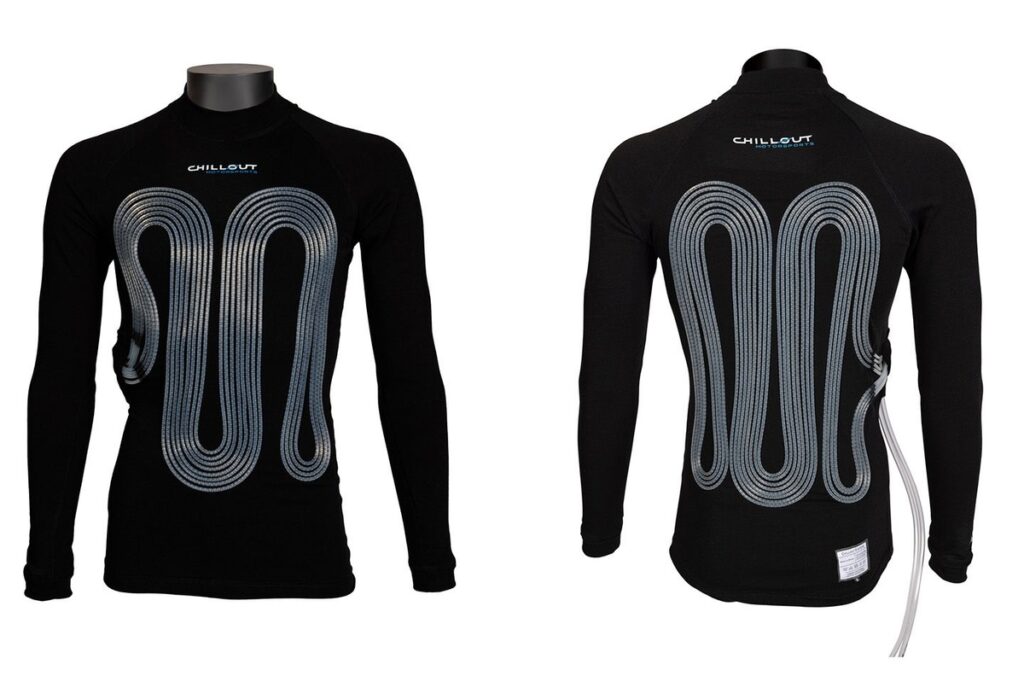The new wearable-tech shirts designed to keep drivers cool in races in extreme heat will be optional for competitors in the 2025 Formula 1 season, Autosport understands.
The devices are being introduced as part of the FIA’s response to the events of the 2023 Qatar Grand Prix, where Logan Sargeant withdrew for Williams with heatstroke, then Alpine driver Esteban Ocon vomited in his helmet and Aston Martin racer Lance Stroll briefly passed out.
As first reported by Autosport, the initial thinking on the topic was to attempt to introduce an ersatz air-conditioning unit to cool car cockpits.
But this was abandoned due to complexities arising in adapting such kit, and so utilising existing wearable-tech – such as the Cypher Pro Micro Cooler produced by Chillout Motorsports (pictured above) – was deemed to be the FIA’s preferred route.
One of the main challenges to this work was ensuring the cooling devices complied with the governing body’s stringent rules on fire resistance for all driver-worn kit in the event of a crash.
The devices combine a shirt with nearly 50 metres of tubes that pump cooled fluid stored in a dedicated box that houses a micro-processor and the technology needed to keep the relevant temperatures down around a driver’s torso.
Driver Cooling system – Chillout Motorsport
Photo by: Chillout Motorsport
In a statement, the FIA has said the “finalisation of the driver cooling system following work carried out between the FIA and the Formula 1 teams, supported by changes to define when such systems must be used” and so was approved by the F1 Commission in London earlier this week.
Autosport understands that this includes defining when the system will need to be used – as its use will only be mandated in the rules for the teams to fit it to their cars when temperatures reach a certain threshold.
This has now been set at 31C ambient temperature on the FIA sensors placed around a typical F1 venue (there are four weather stations erected at each race), rather than being measured on how hot conditions are in car cockpits, which can quickly reach 50-60C.
For the 2026 F1 season, the cooling systems will powered by the differently arranged electrical systems of the new car designs and will therefore be carried at all times.
But for the upcoming campaign, as the system only will be retro-fitted to cars when the 31C mark is reached, Autosport understands that drivers have been given the option of not using it.
The added time before it becomes mandatory will also allow further proof of concept studies to be completed and for the systems to potentially be further tweaked ahead of 2026.

Logan Sargeant, Williams Racing
Photo by: Williams F1
But if a driver chooses not to wear a cooling vest in 2025, it is understood they must still carry an extra 500g in ballast within their cockpits to ensure they do not gain a competitive edge by choosing to take this approach.
At the Hungarian GP last year, when this topic first surfaced in the wake of the FIA’s commitment to ensure the Qatar farce would not be repeated, Lewis Hamilton declared “it’s not needed”.
“This is Formula 1,” he added. “It’s always been like this. It’s tough in these conditions. We’re highly-paid athletes. And you’ve got to train your arse off to make sure you can withstand the heat, ultimately.
“It’s tough. It’s not easy, especially when you go to places like Qatar and Singapore. But I don’t think we need an AC unit in the car.”
In this article
Alex Kalinauckas
Formula 1
Be the first to know and subscribe for real-time news email updates on these topics
Subscribe to news alerts
Read the full article here

